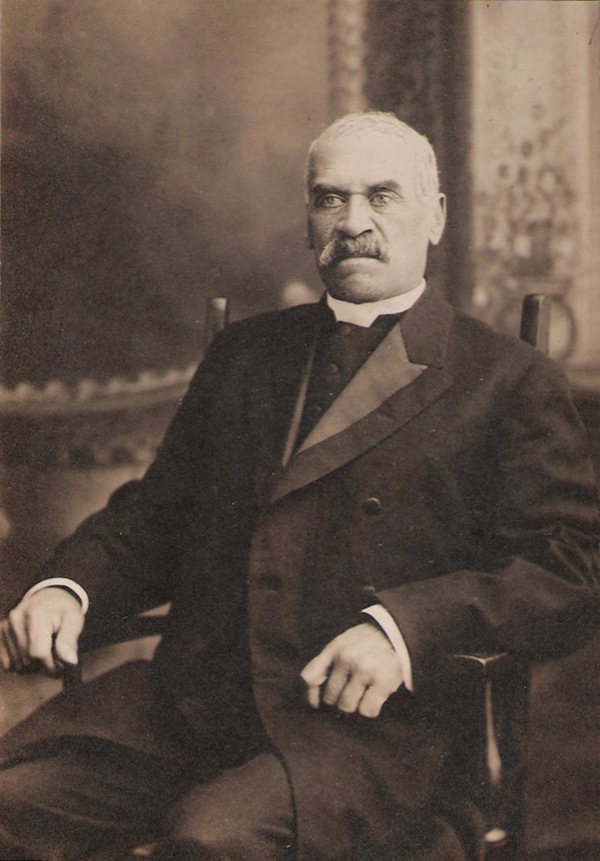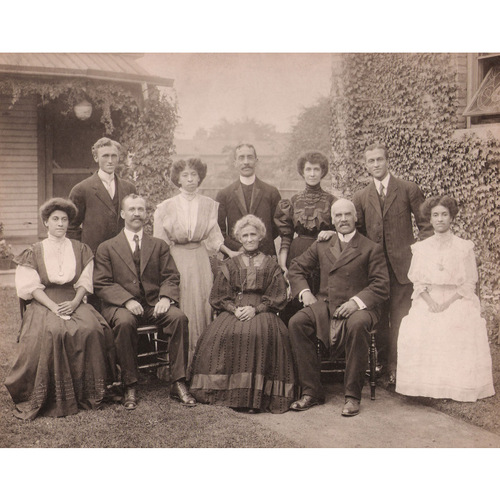
Source: Link
BALL, RICHARD AMOS, barber, British Methodist Episcopal minister, and musician; b. 30 Nov. 1845 in St Catharines, Upper Canada, son of Henry Ball and Sophia Hussey; m. there 7 Dec. 1864 Mary T. Jackson, and they had eight children; d. 22 Dec. 1925 in Windsor, Ont.
By the time of Richard A. Ball’s death in 1925, the legend of the Underground Railroad had established itself firmly in the Canadian imagination. One of his obituaries constantly reminded readers that his family had come to Upper Canada fleeing slavery by this means. According to historian Robin W. Winks, his father was a fugitive slave from Virginia. Ball’s death registration notes that his mother was a native of Liverpool, England, and Ball himself was born in St Catharines. By 1845 it had become a centre of black migration, for free persons as well as ex-slaves from the United States. Ball more than likely knew Harriet Tubman [Ross*], who used the town as her Canadian base, and abolitionist Hiram Wilson, who had set up a mission there for blacks. The public school he attended was no doubt segregated – de facto segregation did exist in St Catharines – and he would have known of the race riot of 1852, in which nearly every home in the black quarter was destroyed by a white mob.
Ball’s first line of work was barbering, which occupied him from the 1860s to the 1880s. Following in the footsteps of his father, a British Methodist Episcopal lay preacher, he became active in the local BME church. (An offshoot of the American Methodist Episcopal Church, the denomination had been established in Upper Canada in 1856 [see Richard Randolph Disney*]). Ball’s marriage in 1864, to 18-year-old Mary Jackson, a Pennsylvania-born black, was conducted by a BME minister, L. C. Chambers. At some point Ball became an elder in his church. In 1892, at the British Methodist Episcopal Church’s annual conference in Windsor, he was ordained deacon. A minister by 1895 – one of about 25 in Canada – he took charge that year of the congregation in Brantford. At the BMEC annual conference held there in 1895, his son Richard R. was made an elder. No doubt the Balls took pride in the knowledge that ministry had thus become a family tradition. Ball Sr subsequently served congregations in Windsor, London, Toronto (1911–16, 1923–24), and Winnipeg (1919–21). In 1914 he and his wife celebrated their golden anniversary at his church on Chestnut Street in Toronto, surrounded, the Toronto Canadian Observer reported, “by their children and a host of friends, numbering 400, which filled the auditorium . . . and almost the balcony.” The guests presented the couple with a purse containing $110 in gold. The chairperson for the evening was former city controller William Peyton Hubbard*.
Music was part and parcel of Ball’s family life as well as of his religion. He and his wife, their children, and their grandchildren all sang and played instruments. This activity led to the formation of the Ball Family Jubilee Singers. Richard was the choral conductor of this gospel-music group, which achieved fame in the United States and Canada, where it toured several times.
Ball served the BMEC in several capacities: elder, deacon, pastor, general agent, temperance advocate, and president of its annual and general conferences. His dedicated involvement earned him tremendous prestige and respect. The colour bar was a fact of life in most of the towns and cities where he pastored. As Ball ministered to beleaguered blacks in these centres, it was common for him and his team to organize educational programs, help church members find jobs, run soup kitchens, and dispense counsel. Through these initiatives, many African Canadians were able to shore up their self-esteem. In the early 1920s Ball attacked any activist black ideology that diminished loyalty to British institutions – a strong feature of the BMEC’s articles of faith – and he fervently resisted efforts to merge the BMEC with the American MEC. He retired at the end of 1924.
While in Windsor with his wife in December 1925 to celebrate his birthday and their anniversary and to visit their son Charles, Ball suffered heart problems and died. His funeral service was held at his church in Toronto. Interred there in Prospect Cemetery, he was survived by a daughter and three sons, among them the Reverend Richard R. Ball, then a BME minister in Rochester, N.Y.
AO, RG 80-27-2, 33: 71; RG 80-8-0-991, no.13490. LAC, RG 31, C1, 1861, 1871, 1881, St Catharines, Ont. (mfm. at AO). TRL, SC, Black hist. file. UCC-C, 53, 96.031C (mfm.). Canadian Observer (Toronto), 14 Dec. 1914. Globe, 24 Dec. 1925. St. Catharines Standard, 23 Dec. 1925. Bee Allen, “Bee Allen, 1911,” in No burden to carry: narratives of black working women in Ontario, 1920s–1950s, ed. Dionne Brand (Toronto, 1991), 105–27. R. R. Ball, “The British-Methodist Episcopal Church of Canada,” Canada, an encyclopædia (Hopkins), 4: 136–37. British Methodist Episcopal Church, The doctrine and discipline of the British Methodist Episcopal Church (Toronto, 1892). Directories, St Catharines, 1875–93; Toronto, 1895–1924. Sheldon Taylor, “The black church in Canada, a rock on which they stood,” Akili ([Toronto]), 2 (1994), no.2: 1–17; no.4: 22–23. R. W. Winks, The blacks in Canada: a history (2nd ed., Montreal and Kingston, Ont., 1997).
Cite This Article
Afua Cooper, “BALL, RICHARD AMOS,” in Dictionary of Canadian Biography, vol. 15, University of Toronto/Université Laval, 2003–, accessed April 4, 2025, https://www.biographi.ca/en/bio/ball_richard_amos_15E.html.
The citation above shows the format for footnotes and endnotes according to the Chicago manual of style (16th edition). Information to be used in other citation formats:
| Permalink: | https://www.biographi.ca/en/bio/ball_richard_amos_15E.html |
| Author of Article: | Afua Cooper |
| Title of Article: | BALL, RICHARD AMOS |
| Publication Name: | Dictionary of Canadian Biography, vol. 15 |
| Publisher: | University of Toronto/Université Laval |
| Year of revision: | 2005 |
| Access Date: | April 4, 2025 |




